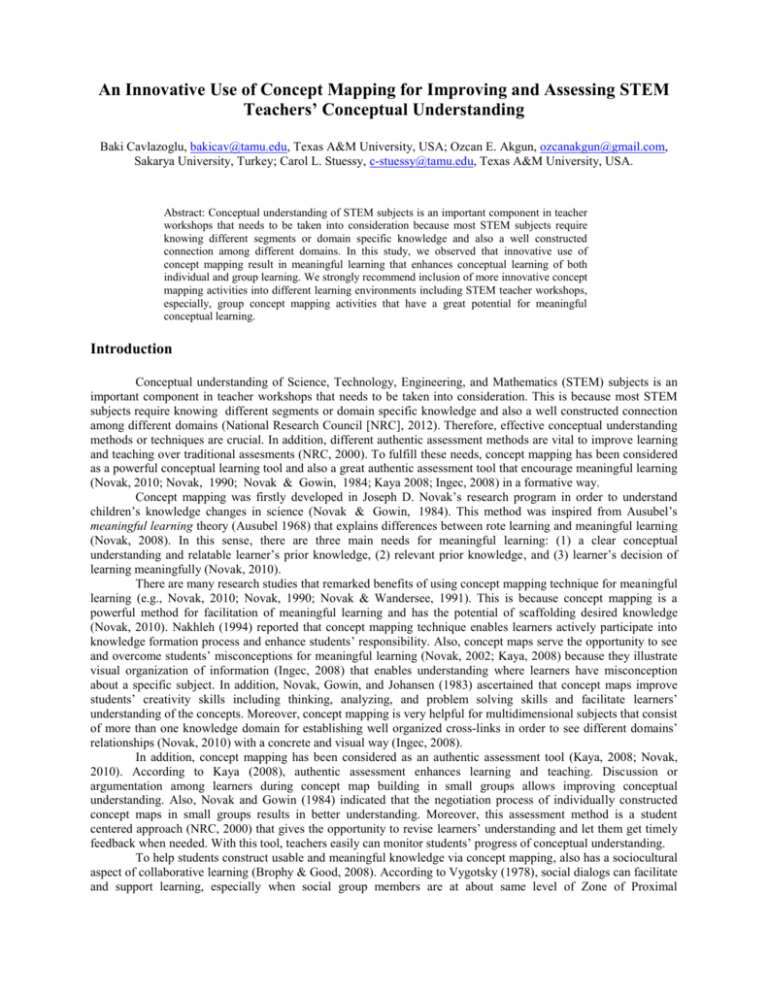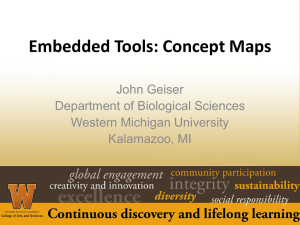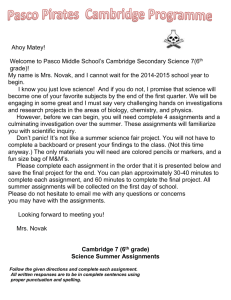An Innovative Use of Concept Mapping for Improving and
advertisement

An Innovative Use of Concept Mapping for Improving and Assessing STEM Teachers’ Conceptual Understanding Baki Cavlazoglu, bakicav@tamu.edu, Texas A&M University, USA; Ozcan E. Akgun, ozcanakgun@gmail.com, Sakarya University, Turkey; Carol L. Stuessy, c-stuessy@tamu.edu, Texas A&M University, USA. Abstract: Conceptual understanding of STEM subjects is an important component in teacher workshops that needs to be taken into consideration because most STEM subjects require knowing different segments or domain specific knowledge and also a well constructed connection among different domains. In this study, we observed that innovative use of concept mapping result in meaningful learning that enhances conceptual learning of both individual and group learning. We strongly recommend inclusion of more innovative concept mapping activities into different learning environments including STEM teacher workshops, especially, group concept mapping activities that have a great potential for meaningful conceptual learning. Introduction Conceptual understanding of Science, Technology, Engineering, and Mathematics (STEM) subjects is an important component in teacher workshops that needs to be taken into consideration. This is because most STEM subjects require knowing different segments or domain specific knowledge and also a well constructed connection among different domains (National Research Council [NRC], 2012). Therefore, effective conceptual understanding methods or techniques are crucial. In addition, different authentic assessment methods are vital to improve learning and teaching over traditional assesments (NRC, 2000). To fulfill these needs, concept mapping has been considered as a powerful conceptual learning tool and also a great authentic assessment tool that encourage meaningful learning (Novak, 2010; Novak, 1990; Novak & Gowin, 1984; Kaya 2008; Ingec, 2008) in a formative way. Concept mapping was firstly developed in Joseph D. Novak’s research program in order to understand children’s knowledge changes in science (Novak & Gowin, 1984). This method was inspired from Ausubel’s meaningful learning theory (Ausubel 1968) that explains differences between rote learning and meaningful learning (Novak, 2008). In this sense, there are three main needs for meaningful learning: (1) a clear conceptual understanding and relatable learner’s prior knowledge, (2) relevant prior knowledge, and (3) learner’s decision of learning meaningfully (Novak, 2010). There are many research studies that remarked benefits of using concept mapping technique for meaningful learning (e.g., Novak, 2010; Novak, 1990; Novak & Wandersee, 1991). This is because concept mapping is a powerful method for facilitation of meaningful learning and has the potential of scaffolding desired knowledge (Novak, 2010). Nakhleh (1994) reported that concept mapping technique enables learners actively participate into knowledge formation process and enhance students’ responsibility. Also, concept maps serve the opportunity to see and overcome students’ misconceptions for meaningful learning (Novak, 2002; Kaya, 2008) because they illustrate visual organization of information (Ingec, 2008) that enables understanding where learners have misconception about a specific subject. In addition, Novak, Gowin, and Johansen (1983) ascertained that concept maps improve students’ creativity skills including thinking, analyzing, and problem solving skills and facilitate learners’ understanding of the concepts. Moreover, concept mapping is very helpful for multidimensional subjects that consist of more than one knowledge domain for establishing well organized cross-links in order to see different domains’ relationships (Novak, 2010) with a concrete and visual way (Ingec, 2008). In addition, concept mapping has been considered as an authentic assessment tool (Kaya, 2008; Novak, 2010). According to Kaya (2008), authentic assessment enhances learning and teaching. Discussion or argumentation among learners during concept map building in small groups allows improving conceptual understanding. Also, Novak and Gowin (1984) indicated that the negotiation process of individually constructed concept maps in small groups results in better understanding. Moreover, this assessment method is a student centered approach (NRC, 2000) that gives the opportunity to revise learners’ understanding and let them get timely feedback when needed. With this tool, teachers easily can monitor students’ progress of conceptual understanding. To help students construct usable and meaningful knowledge via concept mapping, also has a sociocultural aspect of collaborative learning (Brophy & Good, 2008). According to Vygotsky (1978), social dialogs can facilitate and support learning, especially when social group members are at about same level of Zone of Proximal Development (ZPD). ZPD is described as the understanding level of learners for a given subject that learner can progress individually with minimal support from a tutor. In this sense, when students use concept maps to facilitate their learning in groups and work collaboratively, notably greater meaningful learning occurs (Preszler, 2004). Thus, using concept mapping method to guide learners’ learning with adequate collaboration of groups is a great opportunity to facilitate and enhance the learning process. Despite many research studies about use of concept mapping as learning (e.g., Novak & Gowin, 1984; Novak, 2010) and assessment tool (e.g., Kaya, 2008; Ingec, 2008), until very recently there have been few studies that investigate the effect of group concept mapping over individual concept mapping and compare individual and group concept mapping within a different way of use. Hence, the purpose of this study is to find out the effects of group working on innovative use of concept mapping in a STEM teacher workshop. To achieve this purpose, we investigated individual and group concept mapping scores of a group of participants who were enrolled in a summer STEM teacher workshop. Our research questions are: (1) Is there any difference between the quality of concept maps prepared individually and prepared in groups collaboratively? (2) Is there any significant difference between the pre and post concept mapping scores of individuals, and groups? (3) How the individual concept map scores related with group concept map scores? Method The study conducted in one group posttest only design that is one of the pre-experimental designs. This research design also called one shot case study or case study (Salkind, 2010). As the participants were naturally part of the learning environment, there was no random selection for this research. The participants were 14 STEM teachers across the U.S, 5 males and 9 females. For the group concept mapping activity, they were divided into five groups. For this workshop effectiveness and teachers’ conceptual understanding of the workshop subjects, we conducted a pre- concept mapping activity at the beginning of the workshop. Also, at the end of the workshop a post-concept mapping activity was conducted to see how teachers’ conceptual understandings were changed throughout the workshop and how effective the workshop was. Moreover, we aimed to see how group concept mapping activity effect on teachers’ conceptual understanding. The data were collected from individual and group concept maps. The researchers asked participants to use large paper, post-it notes, and markers to construct their concept maps as hands-on activity. This innovative way of using post-it notes on a large paper made easier to organize concepts. In the beginning of first concept mapping activity, a short training about general principals of constructing concept maps was given even though 90% percent of participants had concept mapping experiences and used concept mapping in their teachings. In addition, some good example of concept maps were presented and discussed with participants. After all questions clarified about concept mapping procedures, the teachers were challenged to prepare their first concept maps individually for pretest purpose of the workshop. Then, the teachers randomly were divided into groups to present their concept maps to their group members. After each group member’s presentation of individual concept maps to other teachers in each group and group discussion, every group constructed a group concept map. At the end of the workshop, same procedures were used. Individual and group concept maps within same groups were constructed. We considered number of valid or invalid used concepts, new added concepts, propositions, cross-links, examples and depth according to related literature (Ingec, 2008; Kaya, 2008; Novak & Gowin, 1984) for coding and scoring. Authors scored concept maps independently and found inter-scorer correlations are significant, positive and higher than .82 (see Table 1.). We used descriptive statistics for research question 1, paired t test, and Wilcoxon-Sign test for research question 2, and bivariate correlations for research question 3. Means of two scorers’ points were used for analysis. Table 1. Inter-Scorer Correlations Individual Concept Maps† Pre .95 † Group Concept Maps‡ Post .93 Pre .82 Post .90 Pearson, ‡Spearman-Brown. Results, Discussion and Implications We examined the quality of individual and group concept maps by considering valid use or invalid use of concepts, propositions, cross-link, examples and depth levels for each concept map. According to descriptive statistics, group concept maps scores greatly better than individual concept map scores (see Table 2). It is an interesting finding that although the pre-scores of individual and group concepts map are very close, the post-scores of those are very different. It can be predicted that group concept mapping may yield better results by more experience, but group dynamics of working with same persons or working in groups as a new experience may have different effects on group concept mapping. Table 2. Mean Scores of Concept Maps The Number of Concepts Invalid Valid post pre New added concept The Number of Proposition Invalid Valid The Number of Cross-links Invalid Valid The Number of Examples Invalid Valid Depth Total Score Group 26,80 0,00 9,80 36,80 1,80 0,80 0,00 3,00 0,00 7,80 128,10 Individual 27,83 0,00 5,42 31,08 5,25 0,67 0,00 2,08 0,00 5,83 103,42 Group 25,00 0,00 5,40 9,20 11,60 0,00 0,00 1,60 0,00 2,40 57,00 Individual 22,17 0,25 3,67 11,33 11,17 0,25 0,00 1,67 0,00 2,25 56,54 We employed t test and Wilcoxon-Sign test to examine individual and group pre- and post- concept map scores. It was found that post scores of individual concept maps are significantly higher than individual pre scores (see Table 3), and post scores of group concept maps are significantly higher than group pre scores (see Table 4). These results illustrate that both individual and group concept mapping is a great learning tool that enhance conceptual learning meaningfully and concept mapping works well as an authentic assessment tool for both individual and group learning. Table 3. Paired Sample t Test Results of Individual Concept Map Scores N Mean s Pre 12 56,5417 22,83384 Post 12 103,4167 25,52969 t df p -5.51 11 .000 Table 4. Wilcoxon-Sign Test Results of Group Concept Map Scores Post -Pre Negative Ranks Positive Ranks N Mean Rank Sum of Ranks 0a ,00 ,00 3,00 15,00 5 b c Ties 0 Total 5 z p 2,023 .043 In order to find out the effect of group members’ individual scores in group concept mapping, we calculated mean score of group members’ individual concept map for each group and use it to find out the correlation with group concept map scores. Surprisingly, there is no significant relationship in pre-scores, but postscores have significant, positive and high correlation (see Table 5). This results show that when group members’ individual scores are high, their group scores are high as well in the post-concept mapping, but it is not true in the first concept mapping experience. This means that individual concept mapping experiences positively affect participants’ group concept mapping after a group concept mapping experience. This result can be considered in future researches for the decision process of dividing learners into groups when concept maps are used as learning and assessment tool. Table 5. Spearman Brown Correlation Coefficients Calculated between Group Concept Map Scores and Mean of Group Members Individual Concept Map Scores Spearman's rho Group Pre-Scores Mean of Members Pre- Scores Mean of Members PostScores *p < .05 Group PostScores .40 .30 .90* 1 .60 Mean of Members Pre- Scores .60 1 .70 .60 Group Pre-Scores In conclusion, we observed that our innovative use of concept mapping is a great learning tool for meaningful learning that enhances conceptual learning of both individual and group learning. In addition, this way of using concept mapping is a unique assessment tool that provides much more insight of learning process than traditional assessment methods. We strongly recommend inclusion of more innovative concept mapping activities into different learning environments including STEM teacher workshops, especially, group concept mapping activities that have a great potential for meaningful conceptual learning. Thus, we recommend providing this type of innovative concept mapping activities for learners to greatly facilitate their learning and assess their learning in an authentic way that allows seeing more insights of their learning process. References Ausubel, D. P. (1968). Educational psychology: A cognitive view. New York: Holt, Rinehart and Winston. Brophy & Good. (2008). Looking in classrooms. (10th ed., Vol. 5). Boston: Pearson. Ingec, S.K. (2008). Using concept maps as an assestment tool in physics education. Hacettepe University Journal of Education, 35, 195-206. Kaya, O. N. (2008). A student-centred approach: Assessing the changes in prospective science teachers’ conceptual understanding by concept mapping in a general chemistry laboratory. Research in Science Education, 38, 91–110. DOI 10.1007/s11165-007-9048-7. Nakhleh, M. B., (1994 ). Chemical education research in the laboratory environment. Journal of Chemical Education, 71(3), 201–205. National Science Foundation. (2010). Preparing the next generation of STEM innovators: Identifying and developing our nation’s human capital. Retrieved from http://www.nsf.gov/nsb/publications/2010/nsb1033.pdf National Research Council. (2000). How people learn: Brain, mind, experience and school. Washington, DC: National Academy Press. National Research Council. (2012). A framework for K-12 science education: Practices, crosscutting concepts, and core ideas. Washington, DC: National Academy Press. Novak, J. D. (1990). Concept maps and vee diagrams: Two metacognitive tools for science and mathematics education. Instructional Science, 19, 29-52. Novak, J. D., & Gowin, D. B. (1984). Learning how to learn. New York, NY: Cambridge University Press. Novak, J. D. (2002). Meaningful learning: The essential factor for conceptual change in limited or appropriate propositional hierarchies (liphs) leading to empowerment of learners. Science Education, 86(4), 548-571. Novak, J. D. (2010), Learning, creating, and using knowledge: Concept maps as facilitative tools in schools and corporations. New York, NY: Routledge. Novak, J. D., Gowin, D. B, & Johansen, G. T. (1983). The use of concept mapping and knowledge vee mapping with junior high school science students. Science Education, 67(5), 625–645. Novak, J. D., & Wandersee, J. (1991). Coeditors, special issue on concept mapping. Journal of Research in Science Teaching, 28(10). Preszler, R. W. (2004). Cooperative concept mapping improves performance in biology. Journal of College Science Teaching, 33, 30-35. Salkind, N. J. (2010). Encyclopedia of Research Design, 1st ed, Vol. 1. Thousand Oaks, CA: Sage Publications Vygotsky, L., & Cole, M. (1978). Mind in society: The development of higher psychological processes. Cambridge: Harvard University Press.





